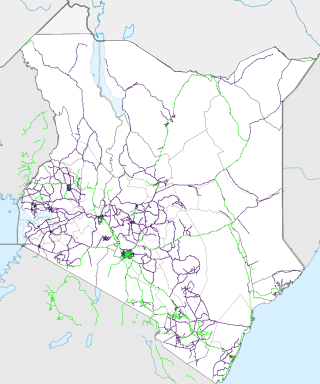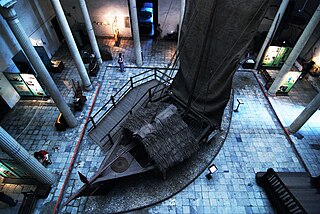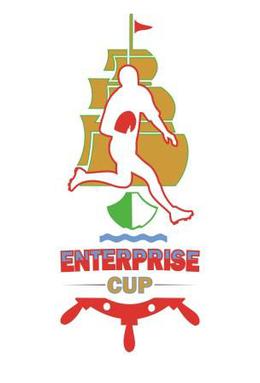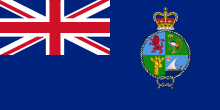
Transport in Kenya refers to the transportation structure in Kenya. The country has an extensive network of paved and unpaved roads.

East Africa, also known as Eastern Africa or the East of Africa, is a region at the eastern edge of the African continent, distinguished by its geographical, historical, and cultural landscape. Defined in varying scopes, the region is recognized in the United Nations Statistics Division scheme as encompassing 18 sovereign states and 4 territories.

The Royal Naval Reserve (RNR) is one of the two volunteer reserve forces of the Royal Navy in the United Kingdom. Together with the Royal Marines Reserve, they form the Maritime Reserve. The present RNR was formed by merging the original Royal Naval Reserve, created in 1859, and the Royal Naval Volunteer Reserve (RNVR), created in 1903. The Royal Naval Reserve has seen action in World War I, World War II, the Iraq War, and War in Afghanistan.

The Uganda Railway was a metre-gauge railway system and former British state-owned railway company. The line linked the interiors of Uganda and Kenya with the Indian Ocean port of Mombasa in Kenya. After a series of mergers and splits, the line is now in the hands of the Kenya Railways Corporation and the Uganda Railways Corporation.
HMS Bassingham was one of 93 ships of the Ham class of inshore minesweepers, of which HMS Inglesham was the first. Their names were all chosen from villages ending in -ham. The minesweeper was named after Bassingham in Lincolnshire. She was built by Vospers Ltd. of Portsmouth, which later became Vosper-Thorneycroft and was commissioned in October 1953. She displaced 164 tons fully laden and was armed with one 40 mm Bofors gun.

The Belgian Navy, officially the Naval Component of the Belgian Armed Forces, is the naval service of Belgium.

The Zanzibar Revolution began on 12 January 1964 and led to the overthrow of the Sultan of Zanzibar and his mainly Arab government by the island's majority Black African population.

Kilindini Harbour is a large, natural deep-water inlet extending inland from Mombasa, Kenya. It is 25–30 fathoms (46–55 m) at its deepest center, although the controlling depth is the outer channel in the port approaches with a dredged depth of 17.5 m (57 ft). It serves as the harbour for Mombasa, with a hinterland extending to Uganda. Kilindini Harbour is the main part of the Port of Mombasa, the only international seaport in Kenya and the biggest port in east Africa. It is managed by the Kenya Ports Authority (KPA). Apart from cargo handling, Mombasa is frequented by cruise ships.

The Myanmar Navy is the naval warfare branch of the armed forces of Myanmar. With 16,000 personnel on duty, the navy operates more than 227 vessels. Prior to 1988, the navy was small, and its role in counter-insurgency operations was smaller than those of the army and the air force. The navy has since been expanded to take on a more active role in defense of Myanmar's territorial waters.

The Ghana Navy (GN) is the naval warfare organizational military branch of the Ghanaian Armed Forces (GAF). The Ghanaian Navy, along with the Ghanaian Army (GA) and Ghanaian Air Force (GHF), make up the Ghanaian Armed Forces (GAF) which are controlled by the Ghanaian Ministry of Defence (MoD).

The Kenya Navy is the naval branch of the Kenya Defence Forces. It is headquartered in Mombasa.

The mtepe is a boat associated with the Swahili people. The mtepe's planks are held together by wooden pegs and coir, so it is a sewn boat designed to be flexible in contrast to the rigid vessels of western technique.

East Africa Command was a Command of the British Army. Until 1947 it was under the direct control of the Army Council and thereafter it became the responsibility of Middle East Command. It was disbanded on 11 December 1963, the day before Kenya became independent, and replaced by British Land Forces Kenya, tasked with withdrawing all remaining British troops. All remaining troops left by December 1964 and British Land Forces Kenya was disestablished.

The Rugby Football Union of East Africa (RFUEA) is an umbrella union for the Kenya Rugby Football Union, Tanzania Rugby Football Union and Uganda Rugby Football Union. It owes its existence to the fact that, prior to independence, Kenya, Tanzania and Uganda were either a protectorate or mandate of the British Empire. It now has little to do with the direct administration of the modern game but it continues to exist in order to promote and support the game in the three countries, to facilitate club competition between the three unions and to administer the RFUEA Ground and the East Africa rugby union team.

The Enterprise Cup is an annual rugby union competition in Kenya, Tanzania and Uganda, though the competition frequently has the appearance of being an all-Kenyan affair as the majority of rugby clubs in the African Great Lakes region are based in this one country and frequently clubs in Tanzania and Uganda are unable to take part due to financial constraints. The original cup was donated by sailors from HMS Enterprise, who had toured British East Africa in 1928. The only years in which the competition has not been played is between 1940–1946 due to World War II and in 1987 because an international rugby competition was held on RFUEA Ground as part of the All Africa Games.
The following is a timeline of the history of the city of Mombasa, Coast Province, Kenya.

788 Naval Air Squadron was a Naval Air Squadron of the Royal Navy's Fleet Air Arm which last disbanded during June 1945. The squadron formed at RN Air Section China Bay in Ceylon, in January 1942, as the British Eastern Fleet's Torpedo Bomber Reconnaissance Pool, however it lost half its strength during the heavy raids by Japanese carrier-borne aircraft in the April. The squadron regrouped at RNAS Tanga in Tanganyika, East Africa to become a Fleet Requirements Unit and relocating almost immediately to RN Air Section Port Reitz, in Mombasa, where it remained operational for the next three years.

795 Naval Air Squadron was a Naval Air Squadron of the Royal Navy's Fleet Air Arm which last disbanded at RNAS Ford, in Sussex, during March 1947. Originally formed as the Eastern Fleet Fighter Pool at RNAS Tanga, in Tanganyika, in June 1942, it’s 'A' Flight's supported the invasion of Madagascar, from HMS Illustrious, before being detached at Majunga on anti-submarine patrols as part of the Royal Air Force’s No. 207 Group. The squadron later moved to RNAS Mackinnon Road, in Kenya, before disbanding during August 1943. It reformed as a Refresher Training Squadron at RNAS Eglinton, in Northern Ireland, in August 1946 as part of the Fleet Air Arm’s 52nd Training Air Group and later included a couple of deployments in HMS Implacable.

796 Naval Air Squadron was a Naval Air Squadron of the Royal Navy's Fleet Air Arm which last disbanded at RNAS Culdrose in October 1958. 796 Naval Air Squadron formed as the Eastern Fleet Torpedo Bomber Reconnaissance Pool, at RN Air Section Port Reitz, in Mombasa, in July 1942, it provided a detachment embarked in HMS Illustrious in August to support the invasion of Madagascar. This Flight also disembarked to Majunga in September to join 207 Group of the Royal Air Force and later rejoined the squadron at RNAS Tanga, in November and added operational training unit to its roles until disbanding in April 1944. It reformed in November 1947 at HMS Vulture, RNAS St Merryn, as the Aircrewman Training School, for conversion of T.A.G.'s to aircrewman standard. Its task changed to Observer School Part II in January 1950. The squadron moved to HMS Seahawk, RNAS Culdrose, in November 1953 and in 1957 took on the task of the disbanded 765 Naval Air Squadron.

During the First World War, the Commander-in-Chief at the Cape, Rear Admiral Herbert King-Hall, expended much effort to destroy the elusive German light cruiser Königsberg.

















